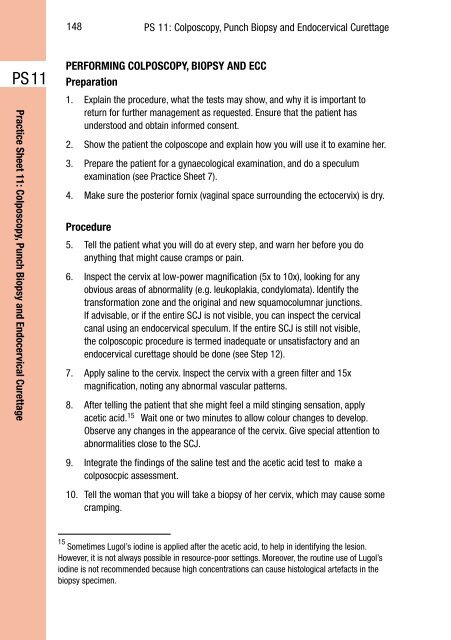CHAPTER 4: SCREENING FOR CERVICAL CANCER
CHAPTER 4: SCREENING FOR CERVICAL CANCER
CHAPTER 4: SCREENING FOR CERVICAL CANCER
You also want an ePaper? Increase the reach of your titles
YUMPU automatically turns print PDFs into web optimized ePapers that Google loves.
148 PS 11: Colposcopy, Punch Biopsy and Endocervical CurettagePS 11Practice Sheet 11: Colposcopy, Punch Biopsy and Endocervical CurettagePER<strong>FOR</strong>MING COLPOSCOPY, BIOPSY AND ECCPreparation1. Explain the procedure, what the tests may show, and why it is important toreturn for further management as requested. Ensure that the patient hasunderstood and obtain informed consent.2. Show the patient the colposcope and explain how you will use it to examine her.3. Prepare the patient for a gynaecological examination, and do a speculumexamination (see Practice Sheet 7).4. Make sure the posterior fornix (vaginal space surrounding the ectocervix) is dry.Procedure5. Tell the patient what you will do at every step, and warn her before you doanything that might cause cramps or pain.6. Inspect the cervix at low-power magnification (5x to 10x), looking for anyobvious areas of abnormality (e.g. leukoplakia, condylomata). Identify thetransformation zone and the original and new squamocolumnar junctions.If advisable, or if the entire SCJ is not visible, you can inspect the cervicalcanal using an endocervical speculum. If the entire SCJ is still not visible,the colposcopic procedure is termed inadequate or unsatisfactory and anendocervical curettage should be done (see Step 12).7. Apply saline to the cervix. Inspect the cervix with a green filter and 15xmagnification, noting any abnormal vascular patterns.8. After telling the patient that she might feel a mild stinging sensation, applyacetic acid. 15 Wait one or two minutes to allow colour changes to develop.Observe any changes in the appearance of the cervix. Give special attention toabnormalities close to the SCJ.9. Integrate the findings of the saline test and the acetic acid test to make acolposocpic assessment.10. Tell the woman that you will take a biopsy of her cervix, which may cause somecramping.15 Sometimes Lugol’s iodine is applied after the acetic acid, to help in identifying the lesion.However, it is not always possible in resource-poor settings. Moreover, the routine use of Lugol’siodine is not recommended because high concentrations can cause histological artefacts in thebiopsy specimen.
















